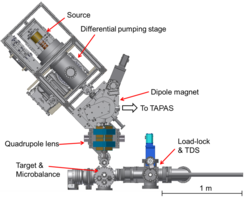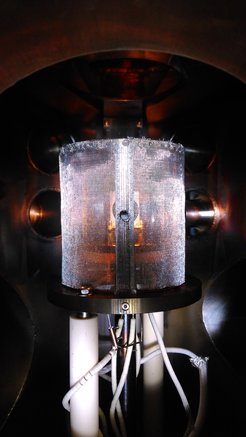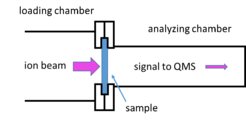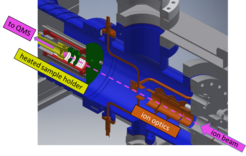Ion Source SIESTA and TAPAS
SIESTA (Second Ion Experiment for Sputtering and TDS Analysis) is an ion source setup used to quantitatively study erosion due to physical sputtering and deuterium retention [1].

Assembly of SIESTA started in 2015, and the experimental test-bed is operational since 2018.
A plasma is operated inside a DuoPIGatron ion source [2] enclosed within a high-voltage cage. Ions are extracted from the ion source into the differential pumping stage with an extraction voltage in the range of several kV.
The ion beam, which has a well-defined ion energy, is deflected in the dipole magnet, resulting in a mass-filtered, monoenergetic beam of the desired ion species (for studies with deuterium typically D3+ ions).

A magnetic quadrupole lens is used to focus the ion beam on a target sample, which is bombarded by the ions. By applying a bias potential to the sample, the impinging ion energy can be reduced as desired, allowing for exposures with an ion energy ranging from 100 eV to several keV. The sample can be weighed before and after exposure with an in-situ microbalance to calculate the erosion due to sputtering by the ion beam. The temperature of the sample can be varied from room temperature up to 1000 K. Additionally, the angle of incidence of the ion onto the surface can be varied between 0° to almost 90°.
SIESTA is equipped with a load-lock for fast sample exchange. With the help of horizontal and vertical manipulators in the load-lock, a sample exposed to the ion beam can be transported to a TDS (Thermal Desorption Spectrometry) chamber located below the load-lock without breaking vacuum. Here, the sample can be heated to allow retained deuterium (or other gases) to desorb from the surface. The desorbed gases are measured and quantified with a quadrupole mass spectrometer.
By inverting the polarity of the dipole magnet, the ion beam of SIESTA can be deflected into another experiment: TAPAS (Test-bed for Analysis of Permeation of Atoms in Samples), which is used to study ion-driven permeation of deuterium through sample materials.

Operating principle of TAPAS
In TAPAS, a thin sample divides two separate vacuum systems. Deuterium ions from SIESTA bombard the sample from the loading side. The deuterium diffuses through the sample until it reaches the opposite side (permeation side). Here, the deuterium atoms desorb from the surface and the permeation signal is registered with a quadrupole mass-spectrometer.

Electrostatic ion-optical elements (an einzel lens, sweeper plates and biased apertures) are used to adjust the position and size of the ion beam. The sample can be heated up to 1000 K. As in the SIESTA target chamber, the sample can be biased to reduce the impinging ion energy as desired.
Assembly of TAPAS started in 2019, and the first experimental campaign took place in summer 2020.
2. R.C. Davis et al., A Multiampere DuoPIGatron Ion Source, Rev. Sci. Instruments 43, 278, 1972;
https://doi.org/10.1063/1.1685611



